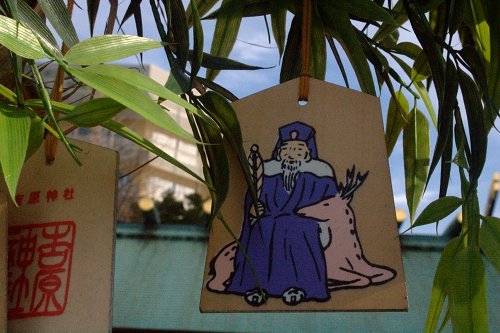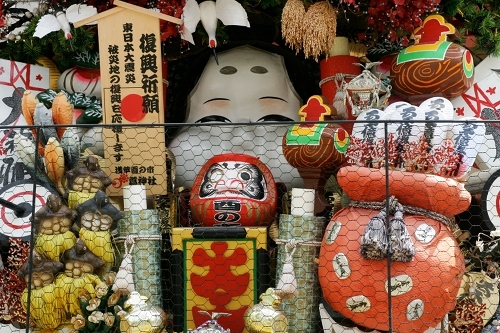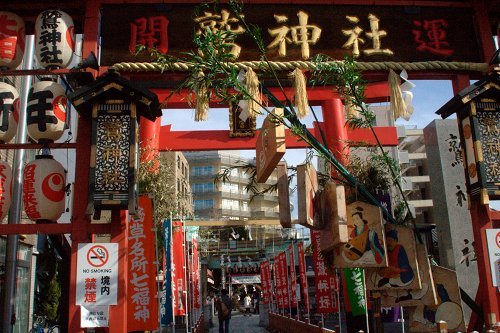Japanese are in love with luck. Lucky charms, lucky days, lucky directions, lucky colors. Tokyo's colorful Asakusa district is just about the luckiest place in town, with shrines and temples to the Seven Gods of Good Fortune all within walking distance.
Otori Jinja Shinto Shrine on the outskirts of Askausa draws huge crowds of luck-seekers all year long. They come to pray to Jurojin, one of the lucky seven, and to touch the shrine's famous Nade Okame (mask you rub).
Even before you walk through the bright red torii gates, the priests have gathered dozens of auspicious symbols displayed on a giant Kuma no De (bear paw rake). Every November, the large shrine hosts a famous festival for these traditional ornaments Japanese hang in homes and businesses to "rake in" all things bright and bountiful.

Jurojin, God of Wisdom and Longevity.
Japanese love their seven lucky gods and they turn up everywhere, often gathered together on a takara bune, treasure ship, helping believers sail off into a brighter future. Preferably with hedge funds. They made their way individually from India and China along the Hindu/Buddhist trail with one Japanese Shinto kami (god/spirit) thrown in for good measure. The importance of praying to Jurojin, the God of Wisdom and Longevity, is to ensure you get a nice, long run to your luck!
The most famous symbol for Otori Jinja is the giant smiling maiden's face carved from a block of cedar. The Nade Okame (mask you rub) is a vital part of Otori Jinja's lucky reputation. She beams at all who make their way up the ramp to the offering box in front of the altar.
It's a two step process for getting Otori's good luck to rub off on you, so pay attention.
Drop some coins in the offering box and ring the bell. Clap your hands twice, bow twice, make your wish -- which flies on a heavenly flight path to Jurojin -- and bow once more.
Now, rub the Nade Okame mask's eyes to become more insightful, her forehead to become clever, her nose for money luck; her right cheek to find your soul mate, left cheek to become healthy, her mouth to protect from bad luck. Lastly, starting from her chin, run your hand around her face in a clockwise motion to make your life go smoothly!
As you look around the inner altar, you'll see many beautiful shrine treasures just beyond the maiden mask, but no statue of Jurojin. In fact, except for the 300 yen good luck charm on sale, his symbol is almost no where to be found.
"How will my prayers to Jurojin be heard when I can't see him?" I asked one of the priests.
"Have faith," he answered.
Oh. Right.
Access: Ten minutes from Iriya Station, Hibiya Metro line. Exit 4. At the top of the stairs, go straight ahead to the next traffic signal. Right at the intersection, then straight for two lights. Otori Jinja is at the big intersection in front of you. Wheelchair accessible. Coming from Asakusa Station? Take a taxi. English website. The Japanese website has lots of pictures, and is fun to scroll through.


